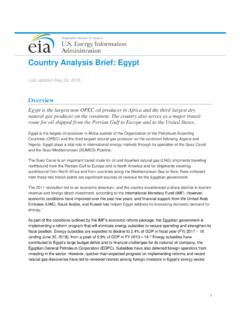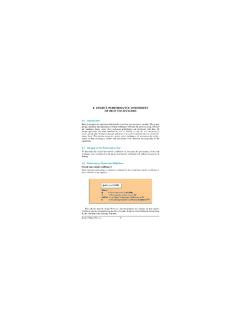Transcription of Steam Pressure Reduction: Opportunities and Issues
1 A BestPractices Steam Technical BriefSteam Pressure reduction : Opportunities and IssuesBestPractices Technical BriefSteam Pressure reduction : Opportunities and Issues Steam Pressure reduction : Opportunities and Issues IntroductionSteam generation systems are found in industry and in the commercial and institutional sectors. Some of these plants employ large watertube boilers to produce saturated Steam at pressures of 250 pounds per square inch (psig) or lower. They distribute Steam for use in process applications, building heating, humidification, domestic hot water, sterilization autoclaves, and air makeup coils. Oversized boiler plants and Steam distribution systems utilizing saturated Steam are potential candidates for reducing the Steam system operating Pressure .
2 Steam systems can have large excess capacity in boilers, valves, pumps, and piping. This can also be true for peak winter is Steam Pressure reduction ? Steam Pressure reduction is the lowering of the Steam Pressure at the boiler plant by means of the Pressure setting on the boiler plant master control. Steam Pressure reduction affects mainly the high Pressure part of the Steam system. Within practical limits, Pressure -reducing valves (PRVs) will adjust the Pressure at lower levels to the previous set points. This means that most of the savings benefits from Pressure reduction occurs in the high Pressure section of the Steam system. Summary1. Steam Pressure reduction has the potential to save fuel consumed by a Steam system. The amount of capital investment may be minimal for the appropriate application of this efficiency measure.
3 The amount of fuel that can be saved varies with the design and maintenance of the existing The potential to effectively reduce Steam Pressure most commonly applies to oversized Steam systems in industry and institutions. These Steam systems supply Steam for process applications and building heating. They are often oversized for summer operation and the peak load period. The operator of the plant must judge whether a boiler plant is Before the Steam plant owner attempts to reduce Steam Pressure , an assessment of the boiler plant and Steam system should be made. This should include an analysis of the average and peak Steam loads in relation to the plant capacity. Data on piping, insulation, and Steam trap condition should be collected. Piping drawings should be used to map out critical Steam loads and the test While energy savings can result from reducing Steam Pressure , there are a significant number of areas where Steam Pressure reduction can reduce the operational effectiveness of the Steam system.
4 These areas should be properly accounted for and Steam Pressure reduction should be tested to establish the critical minimum Pressure at a Steam load that is above average but below peak. This will also provide an estimate of If, prior to reducing boiler Steam Pressure , the boiler is already having carryover Issues , these should be addressed before considering reducing the boiler Steam Pressure . Steam System Losses and Savings Through Pressure reduction A List of Boiler and Steam System LossesIt is useful to summarize the typical causes of boiler and Steam system losses. Most of these losses vary with Steam Pressure (and temperature) and can potentially be reduced by lowering the Steam Pressure at the boiler. BestPractices Technical BriefSteam Pressure reduction : Opportunities and IssuesSome of the main potential losses in a Steam system are noted in Figure 1.
5 Only the energy losses that can be reduced by lowering Steam Pressure will be discussed in this technical brief, and are listed below: Steam leaks from high- Pressure components ( valves and piping) Combustion loss Boiler blowdown loss Steam supplied to the deaerator The enthalpy savings When Steam Pressure is reduced at the boiler, it is only reduced on the high- Pressure side of the system. PRVs, which lower the main Steam Pressure automatically, respond to maintain the Pressure on the downstream side of the valve at the set point, for example, 15 psig. Therefore, losses occurring downstream of the PRV or a backpressure Steam turbine are not reduced by lowering the boiler following example illustrates the potential savings from Steam Pressure reduction .
6 In a Steam system operating at an average Steam load of 38,500 pounds per hour (lb/hr) with one watertube boiler supplying Steam and another on standby, the operating Pressure at the boiler was reduced from 130 psig to 80 psig. The average fuel input to the boiler plant before Steam Pressure reduction is million British thermal units per hour (MMBtu/hr). The plant is modeled using the boiler combustion efficiency as tested over a range of pressures, and with estimates of the size, length, and pressures of distribution and condensate return piping for purposes of calculating radiation losses. Typical losses from radiation and Steam trap leakage based on actual surveys of other facilities are applied. Combustion LossDry flue gas loss as defined by the American Society of Mechanical Engineers (ASME) Power Test Code Combustion Loss BOILERS Deaerator Feedwater Pump Steam to Process Boiler Blowdown Loss Flash Steam Vent Loss Boiler Radiation Loss Steam to Deaerator Deaerator Vent Loss Radiation Loss from High Pressure (HP) Steam Piping HP Steam Leaks from HP, PRV s and other componentsFuel Inputto BoilersPump Main Condensate Return Tank Steam Trap Leaks High Pressure Condensate Receivers Lost Condensate Radiation Loss Cond Piping and Tanks Lost Condensate PumpsSteam Trap Leaks Low Pressure LP Steam Loads PRV HPSteamLoadsSteam Line Condensate Return Line Losses Figure.
7 Boiler and Steam System Losses Flash Steam loss through high- Pressure condensate receiver vents Boiler radiation and convection loss High- Pressure Steam piping heat loss High- Pressure Steam trap leakageBestPractices Technical BriefSteam Pressure reduction : Opportunities and Issues varies directly in proportion to the boiler s net stack temperature (the difference between the flue gas tem-perature and combustion air temperature). When boiler Pressure is lowered, a lower stack temperature results. This, in turn, causes slightly improved combustion efficiency. If the boiler already has an economizer or air preheater, the savings will be somewhat lower. The best way to establish the temperature reduction and savings for a given boiler is to conduct a combustion test at different pressures and constant load.
8 Figure 2 shows the relationship between Pressure and stack temperature for a test on a 65,000 lb/hr watertube boiler operating at a constant output of 38,500 lb/hr. As tested, the boiler stack temperature varies linearly with Steam Pressure . A savings of to of the fuel input can be expected from lower stack temperature. Boiler Radiation and Convection LossFor watertube boilers, radiation loss can be estimated using the American Boiler Manufacturers Association (ABMA) standard radiation loss chart. Radiation losses can also be calculated for any type of boiler, from basic principles using measurements of the boiler surface temperature, area, and emissivity. In this example, the radiation loss is calculated from basic principles. The general formula for calculating radiation loss is:Radiation Loss (Btu/hr), HR = x 10-9 x e (T14 - T24)where x 10-9 = Boltzmann s constant e = Surface emissivity which depends on the specific material and condition (typically ) T1 = The surface temperature as measured ( R) T2 = The ambient temperature as measured ( R)Heat transfer from the surface to the ambient air is increased by the flow of air across the surface.
9 This is called convective heat transfer and must be added to the previously calculated radiation loss. For guidance on calculating convective loss as a function of air velocity, refer to the basic heat transfer texts, for example, Thermal Insulation by John F. Malloy (see Reference list).For this example, when Steam Pressure was reduced from 130 psig to 80 psig, the actual temperature readings on the boiler surface showed an average reduction from 150 F to 140 F. Using the ABMA standard radiation loss chart, this would yield a savings of of the fuel , the ABMA chart does not apply to firetube boilers. Firetube boiler shell loss estimates should be obtained by contacting the boiler manufacturers, or from basic principles and measurements of surface PSIGFlue Gas Temperature Before (T1) and After (T2) Air Pre-HeaterAs tested for a Foster Wheeler 65,000 LB/HR Water-tubed boiler with combustion air pre-heater Stack Temperature F362362387375285362280300T1T2 Figure.
10 Stack Temperature Vs. Boiler Pressure BestPractices Technical BriefSteam Pressure reduction : Opportunities and IssuesBoiler Blowdown LossWhen boiler Pressure is reduced, the blowdown loss is also reduced. If the energy from blowdown is being recovered through a blowdown heat recovery system, there will be no further savings by reducing the boiler Pressure . If however, blowdown water is being drained and flash Steam is being vented, savings will result from Steam Pressure reduction . In the current example, reducing boiler Pressure from 130 psig to 80 psig reduces the sensible heat in the boiler water from 328 Btu/lb to 294 Btu/lb. Assuming a blowdown rate of 4%, the savings is approximately of initial fuel Pressure Steam Piping Heat LossHeat loss from Steam and condensate piping takes place in two stages.












